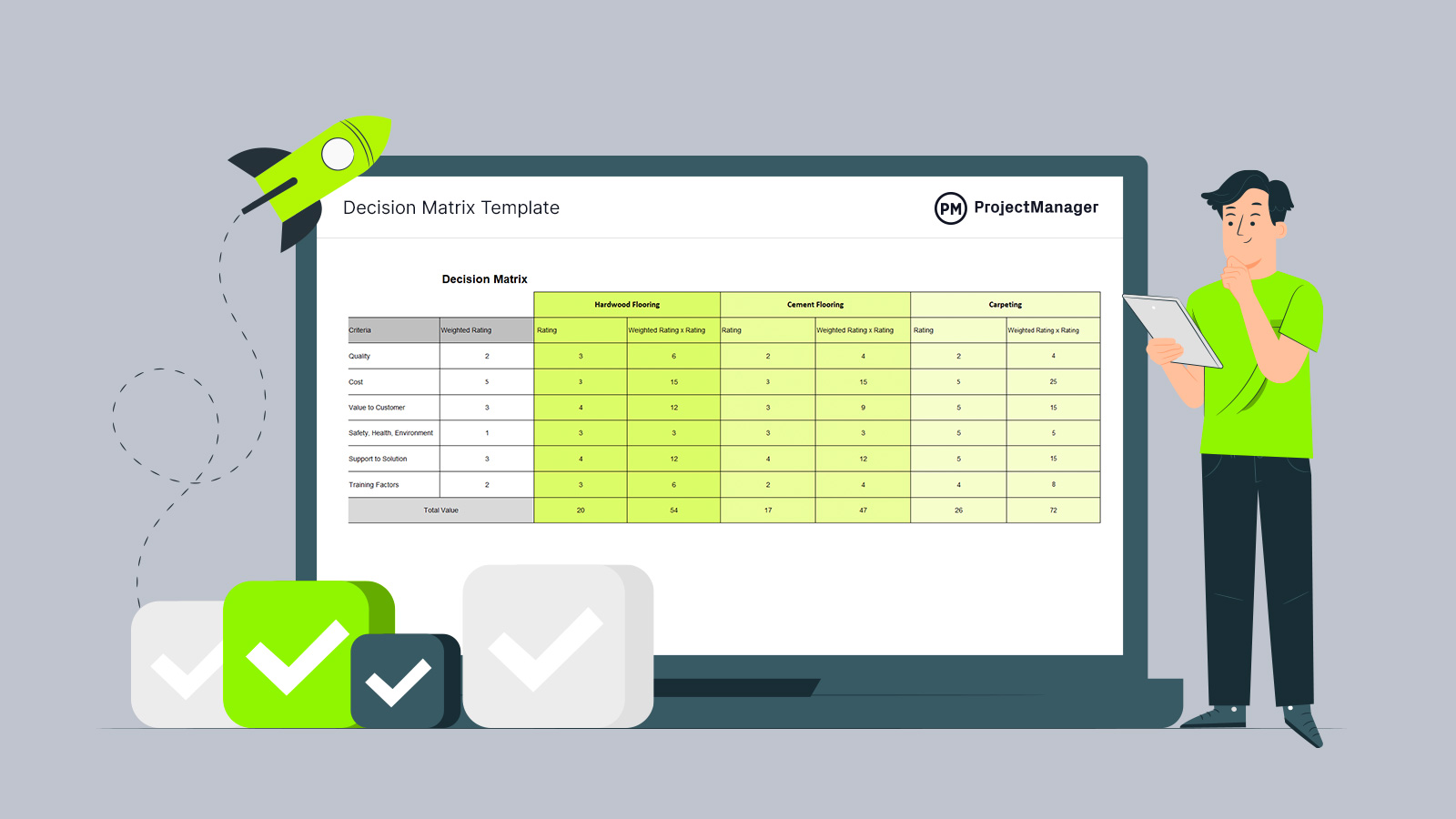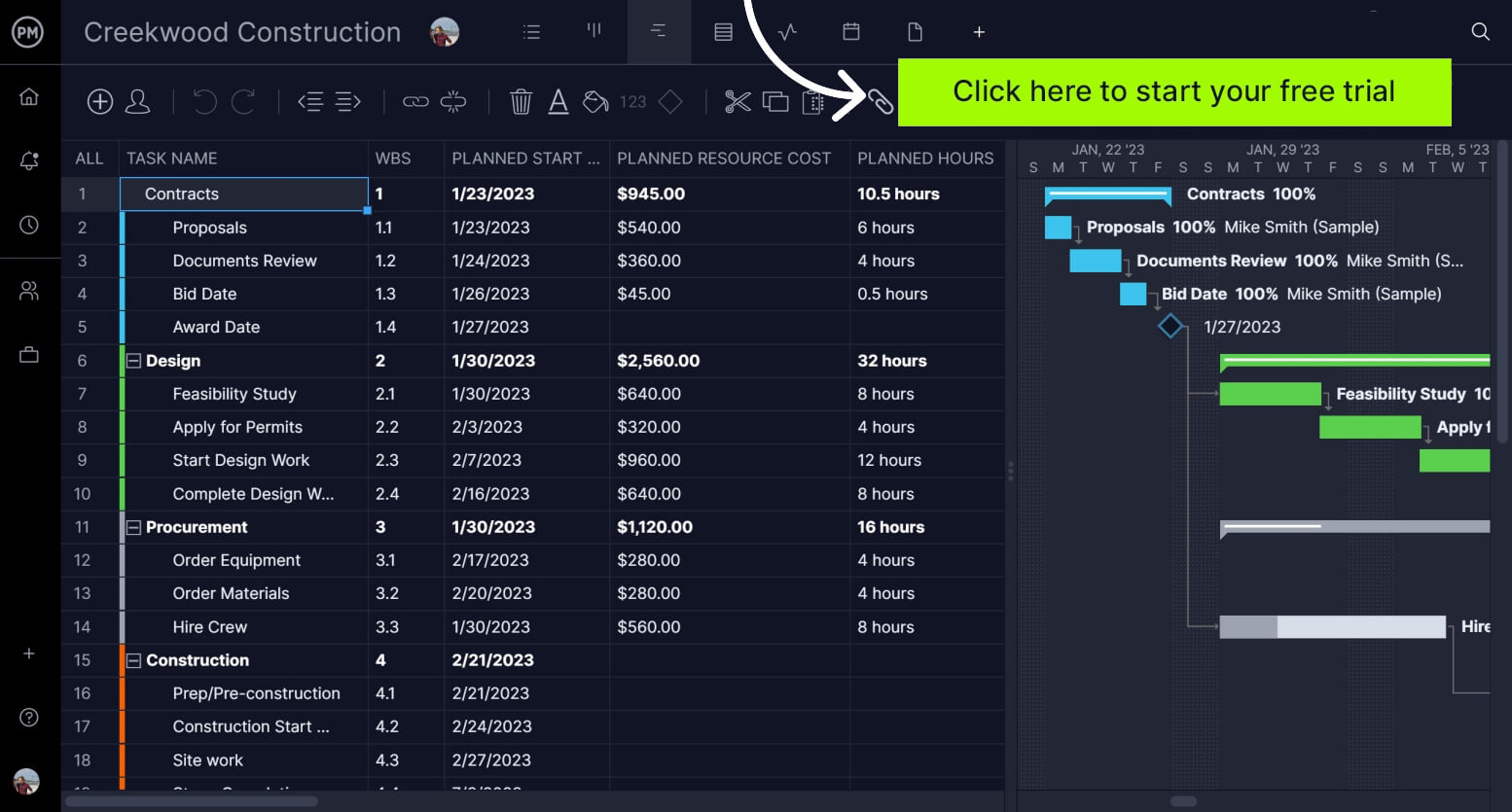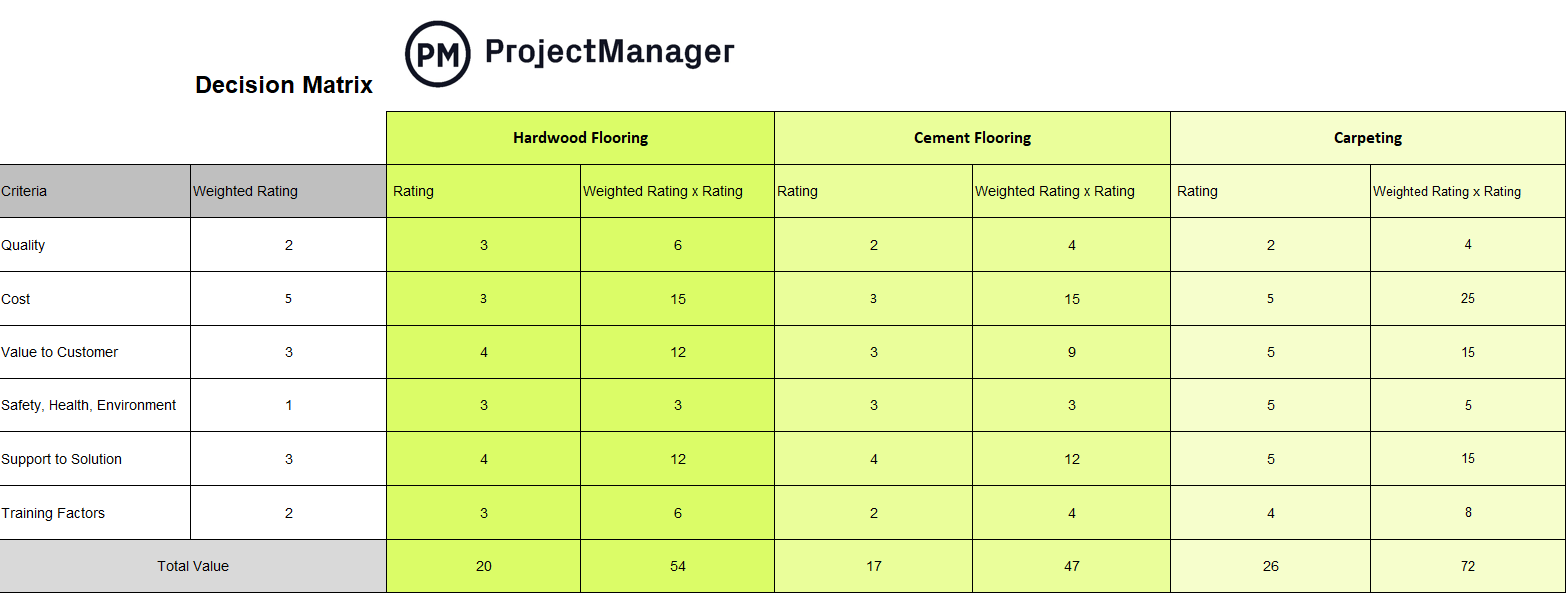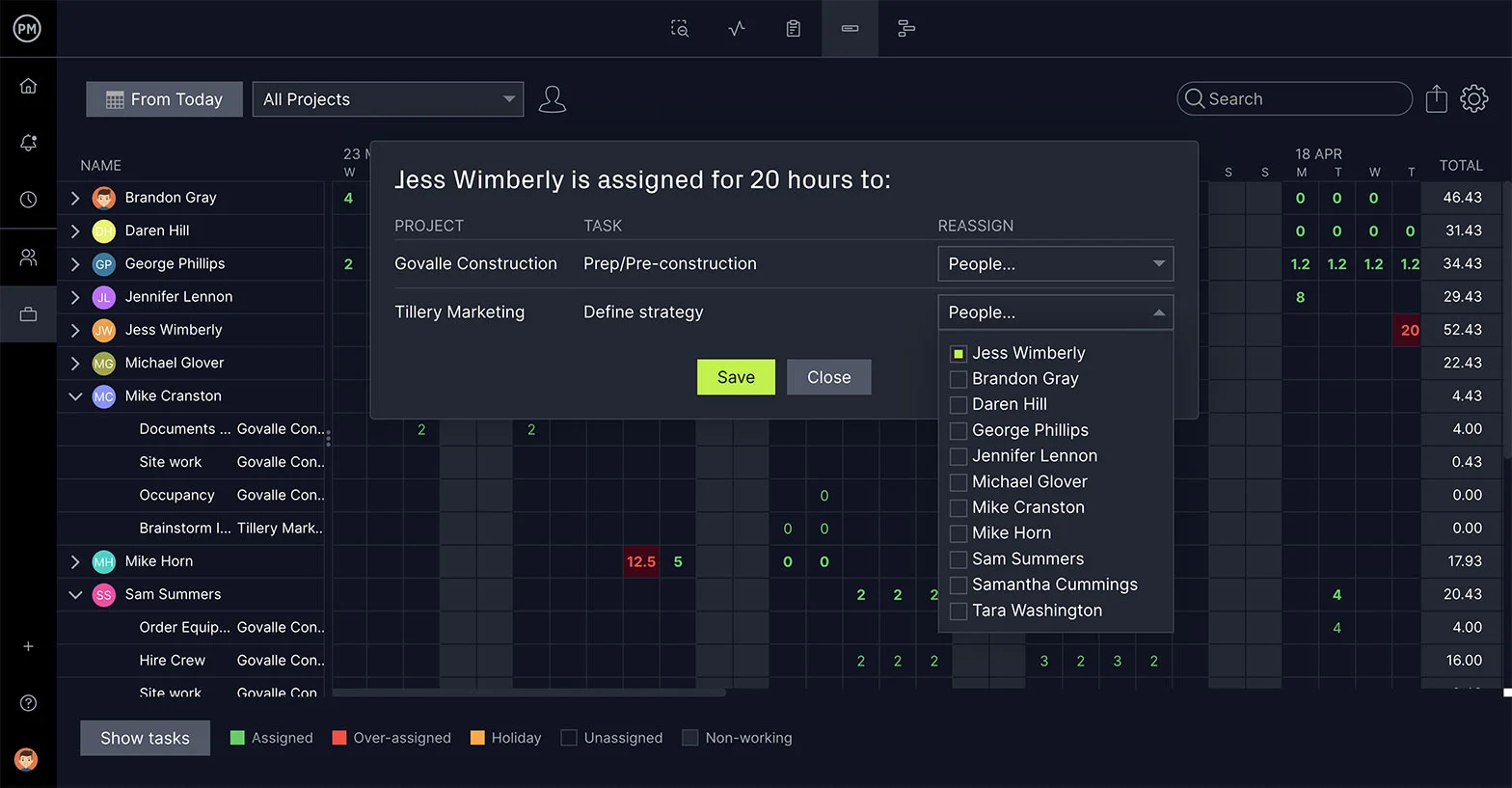Projects can be viewed as a series of decisions. From planning to execution, project managers and their teams are constantly choosing between one option and another or even many different options. Using a decision matrix can help them better evaluate their choices and prioritize work.
Learn what a decision matrix is and when you should use it. We’ll even link to a free decision matrix template for Excel that you can use when next trying to figure out the best course of action. We’ll also explain how to use a decision matrix, list other decision matrices and more.
What Is a Decision Matrix?
A decision matrix is a way to evaluate and prioritize various alternatives to unemotionally and logically choose the best one. This is done by rating each alternative by a set of criteria. That criteria could be cost, quality, ease of use or anything, really. Each alternative is then rated one, being the worst, and five, being the best.
A decision matrix lines up a number or alternatives on the top row, while on the right side is a column that lists the criteria by which you’ll rate each of the alternatives. The rating is usually one through five, with one being the least likely to meet the criteria and five being the most likely to meet the criteria.

Get your free
Decision Matrix Template
Use this free Decision Matrix Template for Excel to manage your projects better.
Decision matrices are best when there’s a large list of alternatives to choose from, but they can be effective tools for prioritizing a smaller set of alternatives. Either way, project managers and their teams can make decisions on their gut, guided by emotion or even unconscious bias. The decision matrix will remove those biases from the decision-making process.
When a decision has been made, then the real work begins and that requires project management software to plan. ProjectManager is award-winning project management software that has powerful Gantt charts that help you schedule your tasks, link all four types of task dependencies and even filter for the critical path to identify the essential tasks. Once you set a baseline, then you can monitor schedule and cost variance in real time to help keep your project on track. Get started with ProjectManager today for free.

When Should You Use a Decision Matrix?
A decision matrix, as the name suggests, is a project management chart used to help one come to a decision. In that case, it can be used in project management or any industry. It can even help one make a personal decision divorced from emotion. But it really comes in handy when you’re managing a project because it helps project managers and their teams evaluate and prioritize their tasks.
Therefore, it can be used at any point in a project’s life cycle, from deciding if the project is worth initiating to any decisions that are necessary during the completion of the project. Basically, you can look at when you should use a decision matrix as whenever you have a lot of options to do something, but you have to narrow it down to one thing to do.
A decision matrix should also be used if you have a set of criteria that the decision has to meet. The decision matrix is a great tool to use those criteria to come up with the best choice. But you can even use it when there have been many options that have been reduced to a few. The decision matrix will help determine which of those few is the right one.
Decision Matrix Example
To make a decision matrix more understandable, let’s explore a made-up scenario in which one would be used. A manufacturing company is looking at a variety of products to introduce into the marketplace. There are four options and four criteria to help them make a choice.
Those criteria include price, which has a weight of four, being the most important factor for the manufacturer. Customer demand has a weight of three, quality has a weight of two and ease of use is rated at one, as it’s the least important factor of the four criteria.
The manufacturer then rates each of the four different products by the four criteria on a decision matrix. The regular rating is multiplied by the weighted rating to create a final score of 30, for product one, 40 for product two, 50 for product three and 60 for product four. Product four has the highest score and that is the product the manufacturer decides to move forward with.
Decision Matrix Template
When making a decision, you can draw a decision matrix on a piece of paper or download our free decision matrix template for Excel. It’s a customizable document that allows you to add as many alternatives as you need to as well as whatever criteria you’d like to use to judge each of the alternatives. Using our free decision matrix template saves you time and you can even archive the document as part of your records and share it with the whole project team to get their input.

How to Make a Decision Matrix
Whether you use our free decision matrix template or make your own, there’s a procedure that you should follow to get the most out of it. These steps will help you get the most out of using a decision matrix.
1. Identify Your Alternatives
Before you begin, you have to have a list of choices from which to evaluate. These can be tasks in a project, which vendors to use, products to make, or even part of your decision-making process when figuring out whether to go forward with a project or not. The alternatives are listed horizontally across the top of your decision matrix.
2. Define a Decision-Making Criteria
The next step is to determine the criteria by which you’ll measure each of the various alternatives on your decision matrix. Criteria can be almost anything, from how much the alternative will cost your company to the return on investment or the quality of your deliverables. You can choose several and they’ll help you weed out the bad choices from the good ones.
3. Create a Scale for the Decision Criteria
A decision criteria scale is simply a best-to-worst rating. On our free decision matrix template, we go from one to five, where one is the least acceptable to five is the most acceptable option. Each of the alternatives will be rated according to each of the specific criteria with this scale.
4. Assign a Weight to Each Decision Criteria Item (Optional)
The weight for each criterion is helpful in determining the importance of each criterion to the various alternatives. It’s not necessary to add weight to the rating, but it can be very helpful in making a decision. A weight scale is usually one to five, with one being not so important and five being very important. For example, if cost is the paramount consideration, then the weight would be five. You’ll multiply the weight rate against the regular weight, with the highest number being your best choice.
5. Create Your Decision Matrix
Now, make the decision matrix. Again, you can download our free decision matrix template or just make a grid on a piece of paper or whiteboard and follow these instructions: alternatives go on the top row—it can be broken into two columns, one for weighted rating and one for regular rating— and the left-hand column is for your criteria.
6. Fill The Decision Matrix
Finally, you’ll fill out the decision matrix by adding a rating to each alternative column, one for weight (if you’re using it) and the other for a normal rating. This is done for each criterion and then is added up to a total, which is multiplied by the total weighted rating if you’re using that. Again, the alternative with the highest rating wins.
Types of Decision Matrices
A decision matrix is only one of several types of decision matrices. You can use it or one of the below. If you want, you can use all of them if the decision is proving difficult to make. Each helps you understand the alternatives better. Here’s a brief explanation of three different types of decision matrices.
Pugh Decision Matrix
A Pugh decision matrix is another criteria-based model that helps you choose the best choice out of many alternatives. It looks very much like the decision matrix we’ve been talking about in that it also works on a grid with alternatives on top and criteria stacked on the side.
Eisenhower Matrix
The Eisenhower matrix is a simpler tool used for task management. It’s a box broken into four quadrants for urgent, not urgent and important, not important. Depending on where you place the task it will be done, scheduled, delegated or deleted.
DACI Matrix
DACI is an acronym for driver, approver, contributor and informed, which is used to define and make clear who has authority in various situations. It is used to assign responsibility and determine the roles of team members in a project.
Benefits of Decision Matrix Analysis
Using a decision matrix is great for taking a complex problem and solving it or prioritizing tasks. But more than that, it provides reasons as to why you made the decision. Because each alternative is measured against a specific criterion you can show why one alternative was chosen over another. It removes the emotional response or even an unconscious bias you might have and leads one to a logical decision that can be defended.
How ProjectManager Helps You Keep Track of Your Projects
There’s a lot of work that goes into decision-making and it’s part of the job of a project manager and their project team. But once that decision has been made, it needs to be acted on. That’s where project management software comes in. ProjectManager is award-winning project management software that helps you plan, manage and track your work in real time. We’ve already shown how you can take a decision and turn it into an actionable plan. Now, let’s look at how you can track that work to ensure that it stays on schedule and within the planned budget.
Track Progress With Real-Time Dashboards
Whenever you need a high-level view of the project’s progress and performance just toggle over to our real-time dashboard. It collects live data and displays it on easy-to-read graphs and charts that show time, cost, workload and much more. Unlike lightweight software tools, our dashboard doesn’t take you away from the project to manually configure the dashboard. Ours is ready when you are with a snapshot of your project in real time.

Keep Track of Labor Costs With Secure Timesheets
Another tool to monitor your project to ensure you’re keeping to the schedule is our secure timesheets. They not only streamline your payroll process and make it easy for timesheets to get auto-filled or just repeat last week’s tasks, but they also provide a window into how productive each team member is by allowing you to see how much of their tasks they’ve completed. Once submitted, timesheets are locked to ensure no tampering.

There are also resource management features that make it easy to see the availability of your team, including PTO, global holidays and vacation time, when making assignments. The color-coded workload chart allows you to see at a glance who is overallocated and then you can balance the team’s workload right from that chart so they’re all working at capacity and staying productive.
ProjectManager is online project management software that connects teams in the field, in the office and all places in between. They can share files, comment at the task level and foster better collaboration. Our software also has automated workflows with task approval settings, task management and risk management features, which help you keep your project on track. Get started with ProjectManager today for free.


